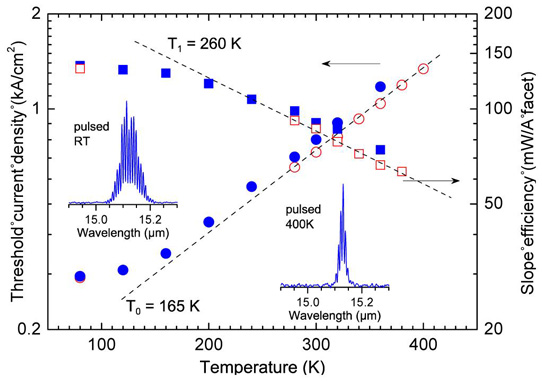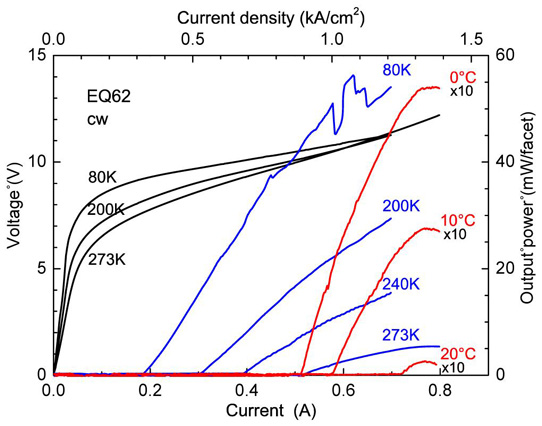- News
24 August 2016
Continuous-wave room-temperature indium arsenide quantum cascade laser
University of Montpellier in France claims the first continuous-wave (cw) operation at room temperature of a 15μm indium arsenide (InAs) quantum cascade laser (QCL) [Alexei N. Baranov et al, Optics Express, vol. 24, p18799, 2016]. "To our knowledge, the longest emission wavelength of RT cw operation for QCLs fabricated from other materials is 12.4μm," the team reports.
The thresholds are also claimed to be the lowest to-date for InAs QCLs.
"One of the reasons of this progress can be attributed to the reduction of optical losses both in the waveguide itself and in the laser active region due to the decreased doping and shorter operating wavelength and thus weaker free carrier absorption," the team comments.
The cascade consisted of 55 active stages with InAs wells and aluminium antimonide (AlSb) barriers. The doping of the active region was reduced by 6x compared with a previous device reported by the same researchers. The QCL structure was grown by molecular beam epitaxy (MBE) on a (100) n-InAs substrate.
The material was fabricated into vertical deep mesa ridge lasers with non-alloyed titanium/gold contacts. The 3.6mm-long devices with cleaved uncoated facets were indium-soldered epi-side down on copper heat-sinks.
The emitted light in pulsed mode (100ns, 40kHz repetition) was around 15μm wavelength at room temperature. The pulsed threshold current density (Jth) varied between 1.22kA/cm2 for a QCL with a 8μm-wide ridge and 0.73kA/cm2 for one with a 20μm ridge. The researchers comment: "The higher Jth in narrow devices is due to a larger overlap of the optical mode with absorbing dielectric on the mesa walls." The team also points out that the threshold current for their previous devices was 4.3kA/cm2 at room temperature.
The 300K slope efficiency from one facet was 90mW/A – a better efficiency of 135mW/A was found at 80K. The previous device had a 3.5W/A efficiency at 300K.
The one-facet peak output power for the 20μm device was 50mW at room temperature. This increased to 100mW at 80K and was still more than 5mW at 400K. The maximum pulsed-mode operating temperature was 410K.
The output power at 80K under continuous-wave operation was 60mW/facet. Some of the best devices operated continuously up to 20°C. Comparing this with the maximum temperature of 400K for pulse-mode operation, the researchers estimate a thermal resistance of the devices at ~10K/W. The team suggests that better heat dissipation could be achieved by thick metalization of the ridge sidewalls. The sidewalls would also need to be suitably insulated with thin dielectric.
A 16μm-wide device had continuous-wave maximum output power of 5.5mW at 0°C and 0.3mW at 20°C. In this range, the threshold current density increased from 0.9kA/cm2 to 1.25kA/cm2.

Figure 1: Threshold current density (circles) and initial slope of light-current curves (squares) in pulsed mode as a function of temperature for lasers with different ridge width: full symbols, 16μm; open symbols 20μm. Inset: emission spectra of 16μm-wide laser at room temperature and at 400K.
The researchers compare their devices with others produced with indium phosphide (InP), but with similar wavelength output: "The most recent InP-based QCLs emitting at 15μm and 14μm exhibited RT threshold current densities of 3.5 and 2kA/cm2, respectively, for devices with high reflection (HR)-coated facets. The corresponding slope efficiencies are 346mW/A for 55 cascades and 375mW/A for 70 cascades, all for HR-coated devices."
Therefore, the InAs devices have a desirable lower threshold, but an undesirable lower slope efficiency, compared with InP-based QCLs.

Figure 2: Voltage-current and light-current characteristics of 16μm-wide laser in cw regime at different temperatures. Output power at temperatures expressed in °C is multiplied by 10.
The improvements for the new QCLs over the group's previous work is attributed in part to better material quality from the Riber 412 MBE tool. The team comments: "This new equipment with big effusion cells provides better flux stability, of the order of 1%, compared with the smaller Riber Compact 21 machine, used previously to grow the reference wafer, where the InAs growth rate tended to decrease during the many hours long growth, resulting in mistuning of the QCL cascades and thus in a smaller gain. The lasers studied in this work could also benefit from the lower residual doping of InAs in the new machine. The cleaner environment results in decreased free-carrier absorption in the laser waveguide."
InAs quantum cascade laser MBE
http://dx.doi.org/10.1364/OE.24.018799
The author Mike Cooke is a freelance technology journalist who has worked in the semiconductor and advanced technology sectors since 1997.


